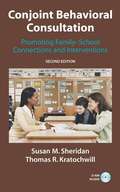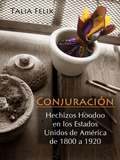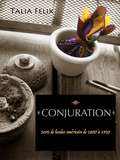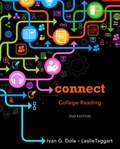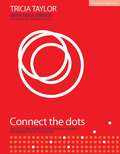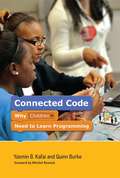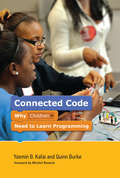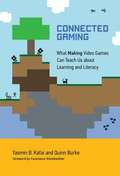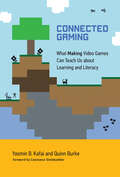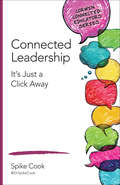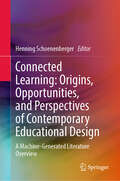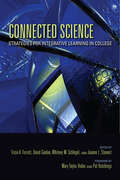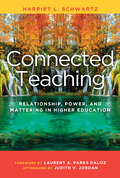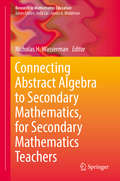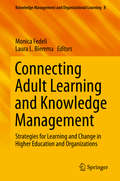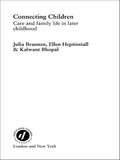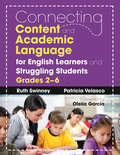- Table View
- List View
Congratulations, by the way: Some Thoughts on Kindness
by George SaundersThree months after George Saunders gave a convocation address at Syracuse University, a transcript of that speech was posted on the website of The New York Times, where its simple, uplifting message struck a deep chord. Within days, it had been shared more than one million times. Why? Because Saunders's words tap into a desire in all of us to lead kinder, more fulfilling lives. Powerful, funny, and wise, Congratulations, by the way is an inspiring message from one of today's most influential and original writers.From the Hardcover edition.
Congress and Policy Making in the 21st Century
by Jenkins Patashnik Eric M. Jeffery A.Congress is frequently said to be 'broken', 'dysfunctional', and 'weak', but how does the contemporary Congress really work? Does Congress have the capacity to solve major policy problems? Can it check an aggrandizing executive, oversee a powerful Federal Reserve, and represent the American people? Can Congress cope with vast changes in the American political economy, including rising income inequality? Congress and Policy Making in the 21st Century takes a fresh look at the performance of Congress in the domestic arena, focusing on issues such as immigration, health care, and the repeal of 'Don't Ask, Don't Tell'. With original contributions from leading scholars, this important volume examines how Congress tackles - and fails to tackle - key policy challenges in an era of growing social diversity and ideological polarization. Rich in analysis and illuminating detail, the book reveals the full complexity of the institution at work.
Congress and the Politics of Problem Solving
by E. Scott Adler John D. WilkersonHow do issues end up on the agenda? Why do lawmakers routinely invest in program oversight and broad policy development? What considerations drive legislative policy change? For many, Congress is an institution consumed by partisan bickering and gridlock. Yet the institution's long history of addressing significant societal problems – even in recent years – seems to contradict this view. Congress and the Politics of Problem Solving argues that the willingness of many voters to hold elected officials accountable for societal conditions is central to appreciating why Congress responds to problems despite the many reasons mustered for why it cannot. The authors show that, across decades of policy making, problem-solving motivations explain why bipartisanship is a common pattern of congressional behavior and offer the best explanation for legislative issue attention and policy change.
Conjoint Behavioral Consultation: Promoting Family-school Connections and Interventions (Second Edition)
by Susan M. Sheridan Thomas R. Kratochwill Jennifer D. Burt Brandy L. Clarke Shannon Dowd-Eagle Diane C. MartiChildren learn within many systems and settings. In the United States, students spend 91% of their time from birth to the age of 18 outside of school. Once in school, they spend 70% of their waking hours outside of school.
Conjuración: Hechizos Hoodoo en los Estados Unidos de América de 1800 a 1920
by Talia FelixUn verdadero relato de la magia hoodoo y vudú tal como se practicaba en tiempos antiguos. El arte mágico del hoodoo ha sido incomprendido desde su existencia. Con este tesoro histórico, serás capaz de observar un genuino estilo de hechizos usado por los practicantes antiguos, incluyendo hechizos del Doctor Buzzard, Marie Laveau, Zora Naele Hurston y otros. Esta nueva edición esta convenientemente organizada por hechizo para una fácil referencia. Conjuros para: BOLSAS DE CONJURO, MANOS, MOJOS Y GRISGRÍS – BOTELLAS Y CALABAZAS – SELLOS Y ESCRITURAS SAGRADAS – DANZAS – HECHIZOS DE AMOR – FIDELIDAD – MATRIMONIO – REMOVER RIVALES AMOROSOS – REGRESAR AMORES PERDIDOR – HECHIZOS DE DINERO – GANAR AL APOSTAR – ÉXITO EN LOS NEGOCIOS – CONSEGUIR EMPLEO – VICTORIA EN LA CORTE – ESCAPAR DE PROBLEMAS LEGALES – SALIR DE LA CARCEL – EVADIR LA CAPUTRA – GANAR JUSTICIA – HECHIZOS DE EMBRUJO, DAÑO Y MUERTE – MUÑECAS VUDÚ – PROTECCIÓN Y REMOVEDOR DE EMBRUJOS – REMOVER BRUJERIA Y CONJUROS ¡Más de 160 hechizos!
Conjuration: Sorts de hoodo américain de 1800 à 1920
by Talia FelixTable des matières Introduction PERSONNALITES ESOTERIQUES OBJETS ET ELEMENTS DE CONJURATION GRIMOIRES & LIVRES DES REVES Racine HIGH JOHN THE CONQUEROR La patte de lapin Les morts Os de chat noir Serpents Sachets et mains de conjuration, mojos & grigris Bouteilles & gourdes SIGILS & ECRITS SACRES Danses Lieux Encens Bougies Poudres SORTS D'ANTAN SORTS D'AMOUR Poudres d’amour Attirer un nouvel amour Attirer une certaine personne Fidélité Mariage Éliminer les rivaux amoureux Récupérer des amants perdus SORTS D'ARGENT Gagner aux paris Succès commercial Pour attirer l'argent Obtenir un travail Chasse au trésor Sorts criminels, juridiques et légaux Pour gagner un procès Échapper aux problèmes légaux Sortir de prison Éviter la capture Obtenir justice MALEFICES, SORTS NOCIFS ET MORTELS Pour tuer Causer la maladie et le malheur Poupées vaudou PROTECTION ET ELIMINATION DES MALEFICES Bains Protection contre le mal Éliminer les sorts et les conjurations DIVERS BIBLIOGRAPHIE
Connect College Reading (2nd Edition)
by Ivan G. Dole Leslie TaggartTaking a holistic approach to developmental reading, CONNECT: COLLEGE READING is an intermediate level book for reading levels 8-10. CONNECT strives to build students' confidence by showing them that many of the skills needed to become stronger readers are skills they already possess and use on a daily basis. Using popular media as a springboard, Dole and Taggart show students how thinking skills used while watching television or movies can easily transfer to reading. CONNECT's comprehensive approach includes extensive vocabulary coverage, critical thinking practice throughout, and textbook readings in every chapter to help students master college reading. The second edition includes a full chapter on inferences, enhanced coverage of main idea, and guides for specialized reading situations such as reading visuals, novels, and a guide to taking tests.
Connect the Dots: The Collective Power of Relationships, Memory and Mindset
by Nina Dibner Tricia TaylorWe are spoiled for choice. Educational research abounds and countless teaching tips and trends are available at our fingertips. Where do you start? Connect the Dots presents three key interconnected areas of focus that will have the most impact on teaching and learning.1. Building Strong Relationships: creating a sense of belonging, establishing norms and high expectations; and understanding barriers, like unconscious bias and misconceptions, in order to break them down 2. Maximising Memory: managing cognitive load, using effective learning strategies, planning for long term retention and application of knowledge 3. Cultivating Learning Mindsets: building self-efficacy; developing metacognitive skills; and using feedback, goal setting and talk effectively.Each of these three chapters lays out the research worth knowing and applies that research to ready-to-use teaching tools for real classrooms. The chapters conclude with detailed guides to support leadership in creating personalised professional learning sessions to turnkey these concepts to school staff. Connect the Dots is a book for educators by educators. Conceived by lead author Tricia Taylor, who started as a teacher in the US but has been teaching in UK schools for nearly two decades as well as running her consultancy, Tailored Practice, and co-authored by Nina Dibner a veteran US educator and founder of PowerTools, an American educational consulting firm, Connect the Dots offers a transcontinental lens. Illustrated by Oliver Caviglioli, the graphics and layout make the book incredibly accessible and a joy to read.
Connect the Dots: The Collective Power of Relationships, Memory and Mindset
by Nina Dibner Tricia TaylorWe are spoiled for choice. Educational research abounds and countless teaching tips and trends are available at our fingertips. Where do you start? Connect the Dots presents three key interconnected areas of focus that will have the most impact on teaching and learning.1. Building Strong Relationships: creating a sense of belonging, establishing norms and high expectations; and understanding barriers, like unconscious bias and misconceptions, in order to break them down 2. Maximising Memory: managing cognitive load, using effective learning strategies, planning for long term retention and application of knowledge 3. Cultivating Learning Mindsets: building self-efficacy; developing metacognitive skills; and using feedback, goal setting and talk effectively.Each of these three chapters lays out the research worth knowing and applies that research to ready-to-use teaching tools for real classrooms. The chapters conclude with detailed guides to support leadership in creating personalised professional learning sessions to turnkey these concepts to school staff. Connect the Dots is a book for educators by educators. Conceived by lead author Tricia Taylor, who started as a teacher in the US but has been teaching in UK schools for nearly two decades as well as running her consultancy, Tailored Practice, and co-authored by Nina Dibner a veteran US educator and founder of PowerTools, an American educational consulting firm, Connect the Dots offers a transcontinental lens. Illustrated by Oliver Caviglioli, the graphics and layout make the book incredibly accessible and a joy to read.
Connected Code
by Yasmin B. Kafai Mitchel Resnick Quinn BurkeCoding, once considered an arcane craft practiced by solitary techies, is now recognized by educators and theorists as a crucial skill, even a new literacy, for all children. Programming is often promoted in K-12 schools as a way to encourage "computational thinking" -- which has now become the umbrella term for understanding what computer science has to contribute to reasoning and communicating in an ever-increasingly digital world.In Connected Code, Yasmin Kafai and Quinn Burke argue that although computational thinking represents an excellent starting point, the broader conception of "computational participation" better captures the twenty-first-century reality. Computational participation moves beyond the individual to focus on wider social networks and a DIY culture of digital "making." Kafai and Burke describe contemporary examples of computational participation: students who code not for the sake of coding but to create games, stories, and animations to share; the emergence of youth programming communities; the practices and ethical challenges of remixing (rather than starting from scratch); and the move beyond stationary screens to programmable toys, tools, and textiles.
Connected Code: Why Children Need to Learn Programming (The John D. and Catherine T. MacArthur Foundation Series on Digital Media and Learning)
by Yasmin B. Kafai Quinn BurkeWhy every child needs to learn to code: the shift from “computational thinking” to computational participation.Coding, once considered an arcane craft practiced by solitary techies, is now recognized by educators and theorists as a crucial skill, even a new literacy, for all children. Programming is often promoted in K-12 schools as a way to encourage “computational thinking”—which has now become the umbrella term for understanding what computer science has to contribute to reasoning and communicating in an ever-increasingly digital world.In Connected Code, Yasmin Kafai and Quinn Burke argue that although computational thinking represents an excellent starting point, the broader conception of “computational participation” better captures the twenty-first-century reality. Computational participation moves beyond the individual to focus on wider social networks and a DIY culture of digital “making.”Kafai and Burke describe contemporary examples of computational participation: students who code not for the sake of coding but to create games, stories, and animations to share; the emergence of youth programming communities; the practices and ethical challenges of remixing (rather than starting from scratch); and the move beyond stationary screens to programmable toys, tools, and textiles.
Connected Gaming: What Making Video Games Can Teach Us about Learning and Literacy
by Constance Steinkuehler Yasmin B. Kafai Quinn BurkeOver the last decade, video games designed to teach academic content have multiplied. Students can learn about Newtonian physics from a game or prep for entry into the army. An emphasis on the instructionist approach to gaming, however, has overshadowed the constructionist approach, in which students learn by designing their own games themselves. In this book, Yasmin Kafai and Quinn Burke discuss the educational benefits of constructionist gaming -- coding, collaboration, and creativity -- and the move from "computational thinking" toward "computational participation." Kafai and Burke point to recent developments that support a shift to game making from game playing, including the game industry's acceptance, and even promotion, of "modding" and the growth of a DIY culture. Kafai and Burke show that student-designed games teach not only such technical skills as programming but also academic subjects. Making games also teaches collaboration, as students frequently work in teams to produce content and then share their games with in class or with others online. Yet Kafai and Burke don't advocate abandoning instructionist for constructionist approaches. Rather, they argue for a more comprehensive, inclusive idea of connected gaming in which both making and gaming play a part.
Connected Gaming: What Making Video Games Can Teach Us about Learning and Literacy (The John D. and Catherine T. MacArthur Foundation Series on Digital Media and Learning)
by Yasmin B. Kafai Quinn BurkeHow making and sharing video games offer educational benefits for coding, collaboration, and creativity.Over the last decade, video games designed to teach academic content have multiplied. Students can learn about Newtonian physics from a game or prep for entry into the army. An emphasis on the instructionist approach to gaming, however, has overshadowed the constructionist approach, in which students learn by designing their own games themselves. In this book, Yasmin Kafai and Quinn Burke discuss the educational benefits of constructionist gaming—coding, collaboration, and creativity—and the move from “computational thinking” toward “computational participation.” Kafai and Burke point to recent developments that support a shift to game making from game playing, including the game industry's acceptance, and even promotion, of “modding” and the growth of a DIY culture. Kafai and Burke show that student-designed games teach not only such technical skills as programming but also academic subjects. Making games also teaches collaboration, as students frequently work in teams to produce content and then share their games with in class or with others online. Yet Kafai and Burke don't advocate abandoning instructionist for constructionist approaches. Rather, they argue for a more comprehensive, inclusive idea of connected gaming in which both making and gaming play a part.
Connected Leadership: It’s Just a Click Away (Corwin Connected Educators Series)
by Spike C. CookYou’re at the top—but never alone! Take the leap and connect with other educators and leaders through social media. Educators learn to transform relationships with their students, staff, parents, and with the overall community in this simple guide to social media. With real-life examples from K12 educators who’ve integrated social media technology and education, this guide helps educators to harness the power of connectedness and change the way you lead. Jump in and you’ll learn how to: Develop a personal learning network Tell your school’s story through blogging Use connections to transform your leadership The Corwin Connected Educators series is your key to unlocking the greatest resource available to all educators: other educators. Being a Connected Educator is more than a set of actions: it’s a belief in the potential of technology to fuel lifelong learning. "This book has practical examples of how educators can use Web 2.0 tools to grow professionally and personally. Cook describes his journey as a lead learner in a way that is easy to read; he inspires, engages, and encourages the reader to move from isolation to connection." Dwight Carter, Principal New Albany High School "After reading this book, you′ll be inspired by the stories of newly connected educators. If you′ve been hesitant to take the plunge into the social media waters, you′ll be ready to jump right in after this quick and informative read." Erin Klein, Teacher and Blogger Kleinspiration
Connected Leadership: It’s Just a Click Away (Corwin Connected Educators Series)
by Spike C. CookYou’re at the top—but never alone! Take the leap and connect with other educators and leaders through social media. Educators learn to transform relationships with their students, staff, parents, and with the overall community in this simple guide to social media. With real-life examples from K12 educators who’ve integrated social media technology and education, this guide helps educators to harness the power of connectedness and change the way you lead. Jump in and you’ll learn how to: Develop a personal learning network Tell your school’s story through blogging Use connections to transform your leadership The Corwin Connected Educators series is your key to unlocking the greatest resource available to all educators: other educators. Being a Connected Educator is more than a set of actions: it’s a belief in the potential of technology to fuel lifelong learning. "This book has practical examples of how educators can use Web 2.0 tools to grow professionally and personally. Cook describes his journey as a lead learner in a way that is easy to read; he inspires, engages, and encourages the reader to move from isolation to connection." Dwight Carter, Principal New Albany High School "After reading this book, you′ll be inspired by the stories of newly connected educators. If you′ve been hesitant to take the plunge into the social media waters, you′ll be ready to jump right in after this quick and informative read." Erin Klein, Teacher and Blogger Kleinspiration
Connected Learning: A Machine-Generated Literature Overview
by Henning SchoenenbergerThis book offers a unique, machine-generated overview of the current state of research in Connected Learning, Networked Learning, Digital Badges, Micro-Credentials, and Lifelong Learning. The concept of Connected Learning picks up learners where they are, and that is no longer just the classroom or seminar room. Connected Learning seeks to understand the context of learning and the motivation of learners in order to design a more contemporary and effective learning experience. Central to this is the understanding that Connected Learning is collaborative and takes place in peer-to-peer networks, that it is based on participation, problem orientation and application, and that the more personalised the learning, the more interested learners are.This volume condenses and synthesizes research from a large variety of English-language articles into a concise yet comprehensive overview. Readers will benefit from the selection and synthesis of articles that allow them to get a quick understanding of the research area, while also being able to click through to the original sources to dive deeper into any particular topic. This volume is a key source of information and insight for those interested in the current research, as well as serving as an inspiring starting point for their own research.
Connected Play: Tweens in a Virtual World
by Yasmin B. Kafai Deborah A. FieldsMillions of children visit virtual worlds every day. In such virtual play spaces as Habbo Hotel, Toontown, and Whyville, kids chat with friends from school, meet new people, construct avatars, and earn and spend virtual currency. In "Connected Play," Yasmin Kafai and Deborah Fields investigate what happens when kids play in virtual worlds, how this matters for their offline lives, and what this means for the design of educational opportunities in digital worlds. Play is fundamentally important for kids development, but, Kafai and Fields argue, to understand play in virtual worlds, we need to connect concerns of development and culture with those of digital media and learning. Kafai and Fields do this through a detailed study of kids play in Whyville, a massive, informal virtual world with educational content for tween players. Combining ethnographic accounts with analysis of logfile data, they present rich portraits and overviews of how kids learn to play in a digital domain, developing certain technological competencies; how kids learn to play well -- responsibly, respectfully, and safely; and how kids learn to play creatively, creating content that becomes a part of the virtual world itself.
Connected Play: Tweens in a Virtual World (The John D. and Catherine T. MacArthur Foundation Series on Digital Media and Learning)
by Yasmin B. Kafai Deborah A. FieldsHow kids play in virtual worlds, how it matters for their offline lives, and what this means for designing educational opportunities.Millions of children visit virtual worlds every day. In such virtual play spaces as Habbo Hotel, Toontown, and Whyville, kids chat with friends from school, meet new people, construct avatars, and earn and spend virtual currency. In Connected Play, Yasmin Kafai and Deborah Fields investigate what happens when kids play in virtual worlds, how this matters for their offline lives, and what this means for the design of educational opportunities in digital worlds. Play is fundamentally important for kids' development, but, Kafai and Fields argue, to understand play in virtual worlds, we need to connect concerns of development and culture with those of digital media and learning. Kafai and Fields do this through a detailed study of kids' play in Whyville, a massive, informal virtual world with educational content for tween players. Combining ethnographic accounts with analysis of logfile data, they present rich portraits and overviews of how kids learn to play in a digital domain, developing certain technological competencies; how kids learn to play well—responsibly, respectfully, and safely; and how kids learn to play creatively, creating content that becomes a part of the virtual world itself.
Connected Science: Strategies for Integrative Learning in College (Scholarship Of Teaching And Learning Ser.)
by Tricia A. Ferrett, David R. Geelan, Whitney M. Schlegel, and Joanne L. StewartInformed by the scholarship of teaching and learning (SOTL), Connected Science presents a new approach to college science education for the 21st century. This interdisciplinary approach stresses integrative learning and pedagogies that engage students through open-ended inquiry, compelling real-world questions, and data-rich experiences. Faculty from a variety of disciplines and institutions present case studies based on research in the classroom, offering insights into student learning goals and best practices in curriculum design. Synthetic chapters bring together themes from the case studies, present an overview of the connected science approach, and identify strategies and future challenges to help move this work forward.
Connected Teaching: Relationship, Power, and Mattering in Higher Education
by Harriet L. SchwartzAt a time when many aspects of the faculty role are in question, Harriet Schwartz, the author of Connected Teaching, argues that the role of teachers is as important as ever and is evolving profoundly. She believes the relationships faculty have with individual students and with classes and cohorts are the essential driver of teaching and learning.This book explores teaching as a relational practice – a practice wherein connection and disconnection with students, power, identity, and emotion shape the teaching and learning endeavor. The author describes moments of energetic deep learning and what makes these powerful moments happen. She calls on readers to be open to and seek relationship, understand their own socio-cultural identity (and how this shapes internal experience and the ways in which they are met in the world), and vigilantly explore and recognize emotion in the teaching endeavor. Connected Teaching is informed and inspired by Relational Cultural Theory (RCT). The premise of RCT is that the experience of engaging in growth-fostering interactions and relationships is essential to human development. RCT’s founding scholars believed the theory would be relevant in many different settings, but this is the first book to apply them to teaching and learning in higher education. In this book, the author shows that RCT has much to offer those devoted to student learning and development, providing a foundation from which to understand the transformative potential of teaching as a relational practice.
Connecting Abstract Algebra to Secondary Mathematics, for Secondary Mathematics Teachers (Research in Mathematics Education)
by Nicholas H. WassermanSecondary mathematics teachers are frequently required to take a large number of mathematics courses – including advanced mathematics courses such as abstract algebra – as part of their initial teacher preparation program and/or their continuing professional development. The content areas of advanced and secondary mathematics are closely connected. Yet, despite this connection many secondary teachers insist that such advanced mathematics is unrelated to their future professional work in the classroom. This edited volume elaborates on some of the connections between abstract algebra and secondary mathematics, including why and in what ways they may be important for secondary teachers. Notably, the volume disseminates research findings about how secondary teachers engage with, and make sense of, abstract algebra ideas, both in general and in relation to their own teaching, as well as offers itself as a place to share practical ideas and resources for secondary mathematics teacher preparation and professional development. Contributors to the book are scholars who have both experience in the mathematical preparation of secondary teachers, especially in relation to abstract algebra, as well as those who have engaged in related educational research. The volume addresses some of the persistent issues in secondary mathematics teacher education in connection to advanced mathematics courses, as well as situates and conceptualizes different ways in which abstract algebra might be influential for teachers of algebra. Connecting Abstract Algebra to Secondary Mathematics, for Secondary Mathematics Teachers is a productive resource for mathematics teacher educators who teach capstone courses or content-focused methods courses, as well as for abstract algebra instructors interested in making connections to secondary mathematics.
Connecting Adult Learning and Knowledge Management: Strategies for Learning and Change in Higher Education and Organizations (Knowledge Management and Organizational Learning #8)
by Laura L. Bierema Monica FedeliThis multidisciplinary book represents an initial attempt to connect adult learning and knowledge management in theory and practice. It provides educators, learners and organizational development professionals with new strategies and resources for developing active and effective pedagogies, which in turn prepare learners and practitioners to manage knowledge in organizations and higher education. To do so, it gathers contributions and case studies from a diverse, global team of authors and provides a theoretical and practical outline of new strategies and methods for facilitating adult teaching and learning. It also provides a fresh reading of active learning methods, by adopting a knowledge management viewpoint that is broadly applicable, whether helping students master content in university courses, or helping organizations learn and change.The book is divided into three main sections: a) methods and theories for adult teaching and learning; b) knowledge management in education; and c) case studies and best practices that consider classroom learning, higher education change, and organization development.
Connecting Animals and Children in Early Childhood
by Patty Born SellyUnderstand the value of connecting animals and childrenFrom family pets and wild animals to toys, stuffed animals, and media images, animals are a central part of every child's landscape. This book examines the reasons why children should interact and connect with real animals, and it identifies the rich learning that results. You'll find heaps of foundational support and practical ideas to create authentic experiences that bring children and all kinds of species of animals together-including many adaptations if live animals are not permitted in your setting.Connecting Animals and Children in Early ChildhoodExamines the basic qualities that make animals so appealing to childrenExplains how animals impact children's cognitive, social-emotional, and inter- and intrapersonal development and growthIncludes an overview of the many ways animals are present in children's livesIntroduces authentic experiences with animals that are supportive of children's understanding and learning, and respectful to both animals and peopleProvides real-life examples of how to bring animals into your classroom with suggestions for planning, ideas for finding the right pet, and resources for making experiences meaningful, relevant, and joyful for childrenPatty Born Selly is executive director of the National Center for STEM Elementary Education at St. Catherine University in St. Paul, Minnesota. As the founder of Small Wonders, an educational consulting company offering services to schools, faith-based communities, and other organizations, Patty has developed hundreds of classes to help programs incorporate nature, science, and green education.
Connecting Children: Care and Family Life in Later Childhood
by Julia Brannen Kalwant Bhopal Ellen HeptinstallConnecting Children focuses on children's understandings of care and their views of different family lives. It portrays the lives of children aged 11-12 and shows how families connect children in different ways both in the household but also in their wider kinship networks. The children studied reflect upon family life and especially upon situations where their own family lives change dramatically, such as when parents divorce or are unable to care for them. This book will be of interest to those working in education, social work, child care, counselling, social policy and childhood studies.
Connecting Content and Academic Language for English Learners and Struggling Students, Grades 2–6
by Ruth Swinney Patricia VelascoCreate unit plans that will empower your EL students Award-winning teacher Ruth Swinney and Harvard graduate Patricia Velasco focus on the careful planning needed to develop the academic language of all students. For English learners especially, it is critically important to integrate language development with content. What makes this book unlike any other is the detailed guidance it provides in: Encouraging verbal expression in the classroom Planning units that link language with content Using shared reading and writing, read alouds, and conversation


